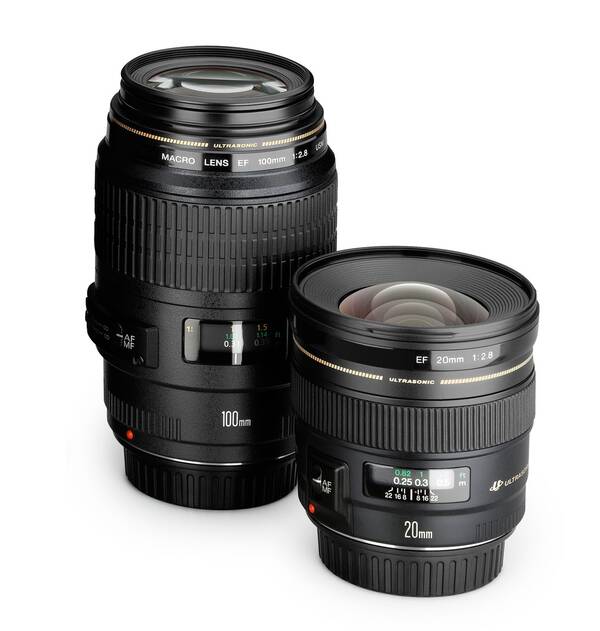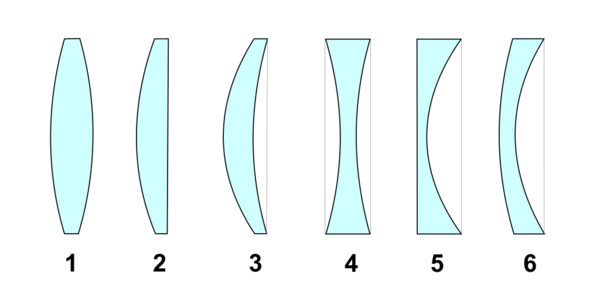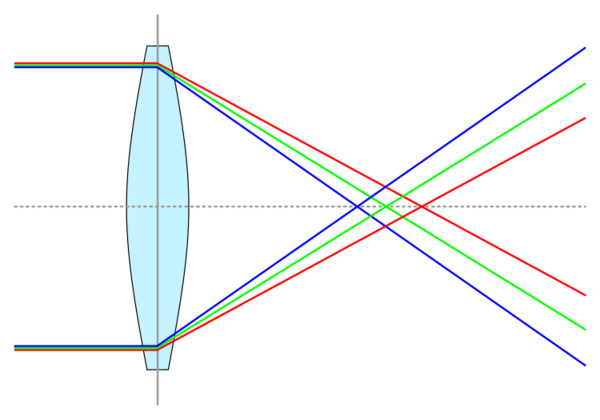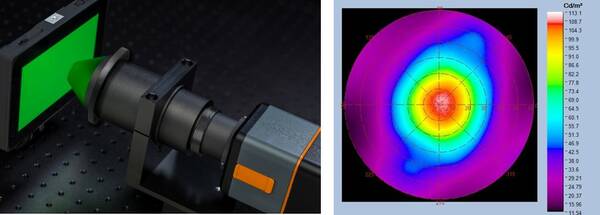Putting the Focus on Lenses
The most important part of any camera is the lens, which directs light in ways that create images to mirror reality. Today’s photographic lenses are sophisticated instruments composed of multiple elements (individual glass or plastic lens discs), paired with an aperture, shutter, and controls, all arranged along a central axis, and held within the lens casing. Minute adjustments allow a user to control the amount of light, exposure time, focus, and other factors that affect the quality of an image. Today’s lenses owe their sophistication to a long history of study and experimentation to understand the behavior of light and how it interacts with various substrates—in other words, optics. In today’s blog, we’ll look back on this history, and preview some innovative lens technologies of the future.

Standard lenses used with Radiant’s ProMetric® Imaging Colorimeters and Photometers.
A Look at Lens History
The first lenses were developed by ancient Mesopotamians, Assyrians, and Egyptians, and were typically made from polished crystals such as quartz.1 The Greeks were the first to develop an understanding of geometrical optics. For example, mathematician Euclid published a treatise, Optics, around 300 B.C. Much later, Arab mathematician Ibn al-Haytham (known as Alhazan and often called “the father of modern optics”) wrote about pinholes, concave lenses, and magnifying glasses in his Book of Optics,2 published in the 10th century A.D. Alhazan also correctly described how lenses refract light.
No one knows for sure when the first glass lenses were developed, but by the 11th-13th century monks were known to use “reading stones” for magnification. These were “primitive planoconvex lenses, initially made by cutting a glass sphere in half.”1 During the Renaissance, the science of lenses was advanced by Galileo and Sir Isaac Newton, among others, in their research and development of telescopes for celestial observation.

The word ‘lens’ is derived from the Latin ‘lentil’ due to the similarity in shape between the legumes (left) and the optical devices (right).
Spectacles are believed to have emerged in the 1300s (possibly near Pisa, Italy). But wearers had to balance them precariously on the nose until the 1700s when a Parisian optician added small rods to the side of eyeglasses to help them stay on; a British optician develop the idea further by adding a curved section to tuck behind the ears.3
Modern Lenses
Lens shapes include convex (the substrate at the center of the lens is thicker than at the edges, such that it curves outward) and concave (the substrate at the center is thinner than at the edges, such that it curves inward), with multiple variations. For example, planoconcave lenses have one flat side (planar) and one concave side, and biconcave lenses are concave on both sides.

Lens shapes include (1) biconvex, (2) planoconvex, (3) and (6) are convex-concave lenses, also called meniscus lenses, (4) biconcave, (5) planoconcave.4
Lenses can be simple (a single layer, for example in a magnifying glass) or compound (multiple lenses aligned together, for example in a compound microscope). Combining multiple lenses amplifies (or ‘compounds’) the effect of each lens, increasing magnification strength, adjusting foci, or correcting chromatic aberrations.
Chromatic Aberration
Each color (the red, blue, and green spectra of light) travels at a different wavelength, and each wavelength of light moves through materials (such as glass) at different speeds. This means two colors of light will reach the same location at different times, causing image distortion. These distortions are known as chromatic aberrations. Combining lenses of different shapes, thicknesses, and characteristics into compound lenses helps to correct chromatic aberrations and provide clear images with high resolution. However, multiple lenses result in a larger piece of camera equipment, such as very long telephoto lenses.

Chromatic aberration occurs as the red, green, and blue wavelengths of light pass through a convex lens at different speeds, resulting in different foci.

The effect of a chromatic aberration in a photographic image.
Camera Lenses
It wasn’t until the early 19th century that cameras were first developed, along with some of the first photographic lenses. Over the next 100-150 years, lens technology underwent much experimentation and development to refine image quality, reduce exposure times, and expand the capabilities of photography. Multiple different lens shapes, configurations, and coatings were tried, more sophisticated apertures and approaches were developed, and the industry saw advancements such as panoramic and telephoto lenses.
In 1925, the Leica 1(A) was the first 35mm lens camera to be sold to the public, and it became an instant hit. Even today, the 35mm lens remains a workhorse of photography for general, professional, scientific, and industrial uses. Radiant’s ProMetric imaging photometers and colorimeters rely on 35 mm lenses, which we use due to the wide variety of high-quality lenses available in this size. These modern lenses offer different focal lengths to meet the requirements of different imaging applications, and have electronic focus capability to provide the precision our customers need.
Lens Technologies of the Future
Optical physicists and engineers continue to push technology forward with the development of advanced new types of lenses. For example, a couple of recent breakthroughs in lens innovation are:
- Liquid Lenses, which use electrical signals to shape a drop of liquid to focus light on a film plane.5 By using liquid for focusing instead of multiple glass or plastic layers, these lenses reportedly can achieve an 85% size reduction,5 and nearly infinite variability with no moving parts.
- Metalenses don't use glass to refract light, but instead rely on nano-fins: tiny waveguide structures made out of materials such as titanium dioxide (as researchers at Harvard's John A. Paulsen School of Engineering and Applied Sciences used in their 2016 breakthrough research6). Because metalenses are flat (planar) and ultra-thin, they do not produce chromatic aberrations: all wavelengths of light pass through virtually simultaneously, creating a single focal point.

This flat metalens is the first single lens that can focus the entire visible spectrum of light—including white light—in the same spot and in high resolution. It uses arrays of titanium dioxide nanofins to equally focus wavelengths of light and eliminate chromatic aberration.6 Photo Credit: Jared Sisler/Harvard SEAS.
Metalenses are still in the experimental phase, but researchers at Columbia Engineering have created a flat, micron-thick lens capable of correctly focusing a large range of colors of any polarization to the same focal point without the need for any additional elements.7 Thinner than a sheet of paper, this type of lens could dramatically reduce the size and weight of optical instruments such as cameras, microscopes, telescopes, and eyeglasses.
Specialty Lenses for Special Optical Measurement Tasks
For today’s consumer devices, displays, lighting, and electronics products, manufacturers often use imaging systems to evaluate quality. Effective visual inspection depends on having reliable, precision lenses to capture images with sufficient detail and accuracy to match human visual perception, for example to spot blemishes on a display or surface. Automated visual inspection technologies that rely on images for defect detection have become commonplace in many industries. However, some types of visual measurement and inspection can’t be done with standard cameras or imaging systems due to form factor or difficult measurement angles. Radiant has developed two specialty lenses to address these challenges:
- FPD Conoscope Lens – The Radiant Vision Systems FPD Conoscope Lens enables high-resolution photopic measurement of the angular distribution of color, luminance, and contrast for flat panel displays (FPDs) and display components from a single point. Radiant uses Fourier optics that map an emitting spot to an image sensor so that each pixel corresponds to a different emission angle. The conoscope lens captures a full cone of view angle data in a single measurement to ±70 degrees. For use with Radiant’s ProMetric imagers, the FPD Conoscope lens provides an angular resolution of 0.05 degrees per image sensor pixel.

Radiant’s FPD Conoscope Lens (left) captures a full cone of view for flat panel displays in a single measurement up to ±70 degrees. Sample of an angular plot (right), with false color to represent measured luminance.
- AR/VR Lens – The Radiant Vision Systems AR/VR Lens has a unique optical design specially engineered for measuring near-eye displays (NEDs), such as those integrated into virtual (VR), mixed (MR), and augmented reality (AR) headsets. The lens design simulates the size, position, and field of view of the human eye. Unlike alternative lens options, where the aperture is located inside the lens, the aperture of the AR/VR lens is located on the front of the lens, enabling positioning of the imaging system’s entrance pupil within NED headsets at the same location as the human eye to capture the immersive display in full.

Radiant’s AR/VR Lens (left) simulates the point of view of the human eye in an AR/VR headset to capture the full field of view of the user in a single image up to 120° horizontal (right).
From telescopes and lighthouses to microscopes and AR eyeglasses, there’s no doubt that lenses in all of their various forms and applications shape the way we “see” the world around us. New innovations continue to open up possibilities for the future of technology, art, medicine, and industry.
Radiant’s optical designs are geared toward capturing light and images the way your users see them—quickly and comprehensively. Do your devices demand new optical geometries or performance? For advanced visual inspection solutions to evaluate product quality, contact us today.
FOOTNOTES:
1. “History of Optics” on Wikipedia (accessed 10/10/18) - https://en.wikipedia.org/wiki/History_of_optics
2. “Alhazen” on Famous Inventors (accessed 10/10/18) - https://www.famousinventors.org/alhazen
3. “Historical Timeline on Lenses, on Windhoek Optics (accessed 10/10/18) - http://www.windhoek-optics.com/index.php/2015-09-03-10-59-08/historical-timeline-on-lenses
4. Image licensed under the Creative Commons Attribution-Share Alike 3.0 Unported license.
5. “Four Innovations that Could Revolutionize the Photography Industry” on PetaPixel - https://petapixel.com/2013/09/18/four-innovations-revolutionize-photography-industry/
6. Burrows, Leah, “Single metalens focuses all colors of the rainbow in one point”, The Harvard Gazette, January 1, 2018 - https://news.harvard.edu/gazette/story/2018/01/ground-breaking-lens-focuses-entire-spectrum-of-light-to-single-point/
7. “Revolutionary Ultra-thin ‘Meta-lens’ Enables Full-color Imaging, on Opli (10/3/2018) - http://www.opli.net/opli_magazine/imaging/2018/revolutionary-ultra-thin-meta-lens-enables-full-color-imaging-oct-news/
Join Mailing List
Stay up to date on our latest products, blog content, and events.
Join our Mailing List
